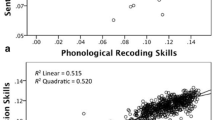Summary
Reading begins with the child’s acquisition of spoken language. Later he learns to differentiate the graphic symbols from one another and to decode these to familiar speech sounds. As he learns the code, he must progressively utilize the structural constraints which are built into it in order to attain the skilled performance which is characterized by processing of higher-order units—the spelling and morphological patterns of the language.
Because of my firm conviction that good pedagogy is based on a deep understanding of the discipline to be taught and the nature of the learning process involved, I have tried to show that the psychology of reading can benefit from a program of theoretical analysis and experiment. An analysis of the reading task—its discriminatory and decoding aspects as well as the semantic and syntactical aspects—tells uswhat must be learned. An analysis of the learning process tells ushow. The consideration of formal instruction comes only after these steps, and its precepts should follow from them.
Similar content being viewed by others
References and Notes
See C. C. Fries,Linguistics and Reading (Holt, Rinehart, and Winston, New York, 1963), for an excellent chapter on past practice and theory in the teaching of reading.
E. J. Gibson, J. J. Gibson, A. D. Pick, H. Osser,J. Comp. Physiol. Psychol. 55, 897 (1962).
E. J. Gibson, H. Osser, W. Schiff, J. Smith, inA Basic Research Program on Reading, Final Report on Cooperative Research Project No. 639 to the Office of Education, Department of Health, Education, and Welfare.
The method was greatly influenced by the analysis of distinctive features of phonemes by Jakobsen and M. Halle, presented inFundamentals of Language (Mouton, The Hague, 1956). A table of 12 features, each in binary opposition, yields a unique pattern for all phonemes, so that any one is distinguishable from any other by its pattern of attributes. A pair of phonemes may differ by any number of features, the minimal distinction being one feature opposition. The features must be invariant under certain transformations and essentially relational, so as to remain distinctive over a wide range of speakers, intonations, and so on.
A. D. Pick,J. Exp. Psychol., in press.
C. H. Bishop,J. Verbal Learning Verbal Behav. 3, 215 (1964).
Current advocates of a revised alphabet who emphasize the low letter-sound correspondence in English are Sir James Pitman and John A. Downing. Pitman’s revised alphabet, called the Initial Teaching Alphabet, consists of 43 characters, some traditional and some new. It is designed for instruction of the beginning reader, who later transfers to traditional English spelling. See I. J. Pitman,J. Roy. Soc. Arts 109, 149 (1961)
J. A. Downing,Brit. J. Educ. Psychol. 32, 166 (1962); ---, “Experiments with Pitman’s initial teaching alphabet in British schools,” paper presented at the Eighth Annual Conference of International Reading Association, Miami, Fla., May 1963.
L. Bloomfield,Elem. Engl. Rev. 19, 125, 183 (1942).
See research reports of H. Levin and J. Watson, and H. Levin, E. Baum, and S. Bostwick, inA Basic Research Program on Reading (see 4).
R. Dodge,Psychol. Bull. 2, 193 (1905).
J. McK. Cattell,Phil. Studies 2, 635 (1885).
D. E. Broadbent,Perception and Communication (Pergamon, New York, 1958).
E. Newman,Am. J. Psychol., in press.
P. A. Kolers and M. T. Katzman, paper presented before the Psychonomic Society, Aug. 1963, Bryn Mawr, Pa.
Spelling patterns in English have been discussed by C. C. Fries inLinguistics and Reading (Holt, Rinehart, and Winston, New York, 1963), p. 169 ff. C. F. Hockett, inA Basic Research Program on Reading (see 4), has made an analysis of English graphic monosyllables which presents regularities of spelling patterns in relation to pronunciation. This study was continued by R. Venezky (thesis, Cornell Univ., 1962), who wrote a computer program for obtaining the regularities of English spelling-to-sound correspondence. The data obtained by means of the computer permit one to look up any vowel or consonant cluster of up to five letters and find its pronunciation in initial, medial, and final positions in a word. Letter environments as well have now been included in the analysis. See also R. H. Weir,Formulation of Grapheme-Phoneme Correspondence Rules to Aid in the Teaching of Reading, Report on Cooperative Research Project No. 5-039 to the Office of Education, Department of Health, Education and Welfare.
E. J. Gibson, A. D. Pick, H. Osser, M. Hammond,Am. J. Psychol. 75, 554 (1962).
E. J. Gibson, H. Osser, A. D. Pick,J. Verbal Learning Verbal Behav. 2, 142, (1963).
E. J. Gibson, C. H. Bishop, W. Schiff, J. Smith,J. Exp. Psychol.,67, 173 (1964).
G. A. Miller and S. Isard,J. Verbal Learning Verbal Behav. 2, 217 (1963)
L. E. Marks and G. A. Miller, ——ibid.3, 1 (1964).
Author information
Authors and Affiliations
Additional information
This article is adapted from a paper used at a conference on Perceptual and Linguistic Aspects of Reading, sponsored by the Committee on Learning and the Educational Process of the Social Science Research Council and held at the Center for Advanced Study in the Behavioral Sciences, Palo Alto, California, 31, October 1963.
Reprinted by permission of the Author and Publisher from Science, V. 148, No. 3673, 21 May 1965.
Rights and permissions
About this article
Cite this article
Gibson, E.J. Learning to read. Bulletin of the Orton Society 15, 32–47 (1965). https://doi.org/10.1007/BF02653756
Issue Date:
DOI: https://doi.org/10.1007/BF02653756




